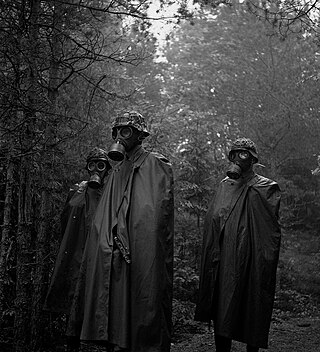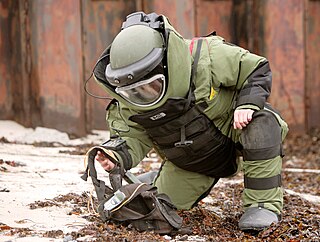Related Research Articles

Personal protective equipment (PPE) is protective clothing, helmets, goggles, or other garments or equipment designed to protect the wearer's body from injury or infection. The hazards addressed by protective equipment include physical, electrical, heat, chemicals, biohazards, and airborne particulate matter. Protective equipment may be worn for job-related occupational safety and health purposes, as well as for sports and other recreational activities. Protective clothing is applied to traditional categories of clothing, and protective gear applies to items such as pads, guards, shields, or masks, and others. PPE suits can be similar in appearance to a cleanroom suit.

Hyperthermia, also known simply as overheating, is a condition in which an individual's body temperature is elevated beyond normal due to failed thermoregulation. The person's body produces or absorbs more heat than it dissipates. When extreme temperature elevation occurs, it becomes a medical emergency requiring immediate treatment to prevent disability or death. Almost half a million deaths are recorded every year from hyperthermia.

A bulletproof vest, also known as a ballistic vest or a bullet-resistant vest, is an item of body armor that helps absorb the impact and reduce or stop penetration to the torso from firearm-fired projectiles and fragmentation from explosions. The vest may come in a soft form, as worn by many police officers, prison guards, security guards, and some private citizens, used to protect against stabbing attacks or light projectiles, or hard form, using metallic or para-aramid components. Soldiers and police tactical units wear hard armors, either in conjunction with soft armor or alone, to protect against rifle ammunition or fragmentation.

To improve motorcycle safety, many countries mandate the wearing of personal protective equipment such as protective clothing and helmets. Protective clothing may include certain types of jackets, gloves, boots, and pants. Jackets meant for motorcyclists are typically made of leather or specialized man-made fabrics like cordura or Kevlar. These jackets typically include padding on the elbow, spine, and shoulder regions. This was once quite bulky, but modern technology and materials have made it unobtrusive. Gloves are generally made of leather or Kevlar and some include carbon fiber knuckle protection. Boots, especially those for sport riding, include reinforcement and plastic caps on the ankle and toe areas. Pants are usually leather, cordura, or Kevlar. Except for helmets, none of these items are required by law in any state in the USA, or in any part of the UK but are recommended by many of those who ride.

A hard hat is a type of helmet predominantly used in workplace environments such as industrial or construction sites to protect the head from injury due to falling objects, impact with other objects, debris, rain, and electric shock. Suspension bands inside the helmet spread the helmet's weight and the force of any impact over the top of the head. A suspension also provides space of approximately 30 mm between the helmet's shell and the wearer's head, so that if an object strikes the shell, the impact is less likely to be transmitted directly to the skull. Some helmet shells have a mid-line reinforcement ridge to improve impact resistance. The rock climbing helmet fulfills a very similar role in a different context and has a very similar design.

Body armor, personal armor, armored suit (armoured) or coat of armor, among others, is protective clothing designed to absorb or deflect physical attacks. Historically used to protect military personnel, today it is also used by various types of police, private security guards or bodyguards, and occasionally ordinary citizens. Today there are two main types: regular non-plated body armor for moderate to substantial protection, and hard-plate reinforced body armor for maximum protection, such as used by combat soldiers.

Eye protection is protective gear for the eyes, and sometimes face, designed to reduce the risk of injury. Examples of risks requiring eye protection can include: impact from particles or debris, light or radiation, wind blast, heat, sea spray or impact from some type of ball or puck used in sports.
Motorcycle armor is body armor for motorcycle riders. It comes in a variety of forms, from traditional yellow foam to high-tech compounds capable of absorbing large amounts of energy. In its basic form an armored jacket will include shoulder and elbow armor, and many jackets can have an optional back protector added too. Trousers should include hip and knee protection, and sometimes a coccyx protector too.

Blunt trauma, also known as blunt force trauma or non-penetrating trauma, is physical trauma or impactful force to a body part, often occurring with road traffic collisions, direct blows, assaults, injuries during sports, and particularly in the elderly who fall. It is contrasted with penetrating trauma which occurs when an object pierces the skin and enters a tissue of the body, creating an open wound and bruise.

A face shield, an item of personal protective equipment (PPE), aims to protect the wearer's entire face from hazards such as flying objects and road debris, chemical splashes, or potentially infectious materials. Depending on the type used, a face shield may protect its wearer from a physical hazard, chemical splashes, or biological hazards.

An NBC suit, also called a chem suit, or chemical suit is a type of military personal protective equipment. NBC suits are designed to provide protection against direct contact with and contamination by radioactive, biological or chemical substances, and provide protection from contamination with radioactive materials and all types of radiation. They are generally designed to be worn for extended periods to allow the wearer to fight while under threat of or under actual nuclear, biological, or chemical attack. The civilian equivalent is the hazmat suit. The term NBC has been replaced by CBRN, with the addition of the new threat of radiological weapons.

The Hazardous Materials Identification System (HMIS) is a numerical hazard rating that incorporates the use of labels with color developed by the American Coatings Association as a compliance aid for the OSHA Hazard Communication (HazCom) Standard.

An arc flash is the light and heat produced as part of an arc fault, a type of electrical explosion or discharge that results from a connection through air to ground or another voltage phase in an electrical system.

Bunker gear is the personal protective equipment (PPE) used by firefighters. The term is derived from the fact that the trousers and boots are traditionally kept by the firefighters bunk at the fire station to be readily available for use.

A bomb suit, Explosive Ordnance Disposal (EOD) suit or a blast suit is a heavy suit of body armor designed to withstand the pressure generated by a bomb and any fragments the bomb may produce. It is usually worn by trained personnel attempting bomb disposal. In contrast to ballistic body armors, which usually focus on protecting the torso and head, a bomb suit must protect all parts of the body, since the dangers posed by a bomb's explosion affect the entire body.

Fall arrest is the form of fall protection which involves the safe stopping of a person already falling. It is one of several forms of fall protection, forms which also include fall guarding and fall restraint.

A physical hazard is an agent, factor or circumstance that can cause harm with contact. They can be classified as type of occupational hazard or environmental hazard. Physical hazards include ergonomic hazards, radiation, heat and cold stress, vibration hazards, and noise hazards. Engineering controls are often used to mitigate physical hazards.

The use of personal protective equipment (PPE) is inherent in the theory of universal precaution, which requires specialized clothing or equipment for the protection of individuals from hazard. The term is defined by the Occupational Safety and Health Administration (OSHA), which is responsible for PPE regulation, as the "equipment that protects employees from serious injury or illness resulting from contact with chemical, radiological, physical, electrical, mechanical, or other hazards." While there are common forms of PPEs such as gloves, eye shields, and respirators, the standard set in the OSHA definition indicates a wide coverage. This means that PPE involves a sizable range of equipment. There are several ways to classify them such as how gears could be physiological or environmental. The following list, however, sorts personal protective equipment according to function and body area.
Prehospital ultrasound is the specialized application of ultrasound by paramedics, to guide immediate care and treatment procedures. Like conventional ultrasound, it is a device that produces cyclic sound pressure to penetrate a medium (flesh) and reveal details about the inner structure of the medium.
Occupational heat stress is the net load to which a worker is exposed from the combined contributions of metabolic heat, environmental factors, and clothing worn which results in an increase in heat storage in the body. Heat stress can result in heat-related illnesses, such as heat stroke, hyperthermia, heat exhaustion, heat cramps, heat rashes and chronic kidney disease. Although heat exhaustion is less severe, heat stroke is a medical emergency and requires emergency treatment, which if not provided can even lead to death.
References
- ↑ Baker, S.P.; B. O'Neill; W. Haddon Jr; W.B. Long (1974). "The Injury Severity Score: a method for describing patients with multiple injuries and evaluating emergency care". The Journal of Trauma. Lippincott Williams & Wilkins. 14 (3): 187–196. doi: 10.1097/00005373-197403000-00001 . PMID 4814394.
- ↑ Copes, W.S.; H.R. Champion; W.J. Sacco; M.M. Lawnick; S.L. Keast; L.W. Bain (1988). "The Injury Severity Score revisited". The Journal of Trauma. Lippincott Williams & Wilkins. 28 (1): 69–77. doi: 10.1097/00005373-198801000-00010 . PMID 3123707.
- ↑ CAN/CSA Z617-06 Standard Archived January 16, 2011, at the Wayback Machine . Canadian Standards Association.
- ↑ HOSDB Blunt Trauma Protector Standard. Home Office Scientific Development Branch.
- ↑ Ergonomic Redesign of PPE. IOS Press.
- ↑ Osha QuickCard Archived 2009-06-27 at the Wayback Machine . Occupational Safety and Health Administration.